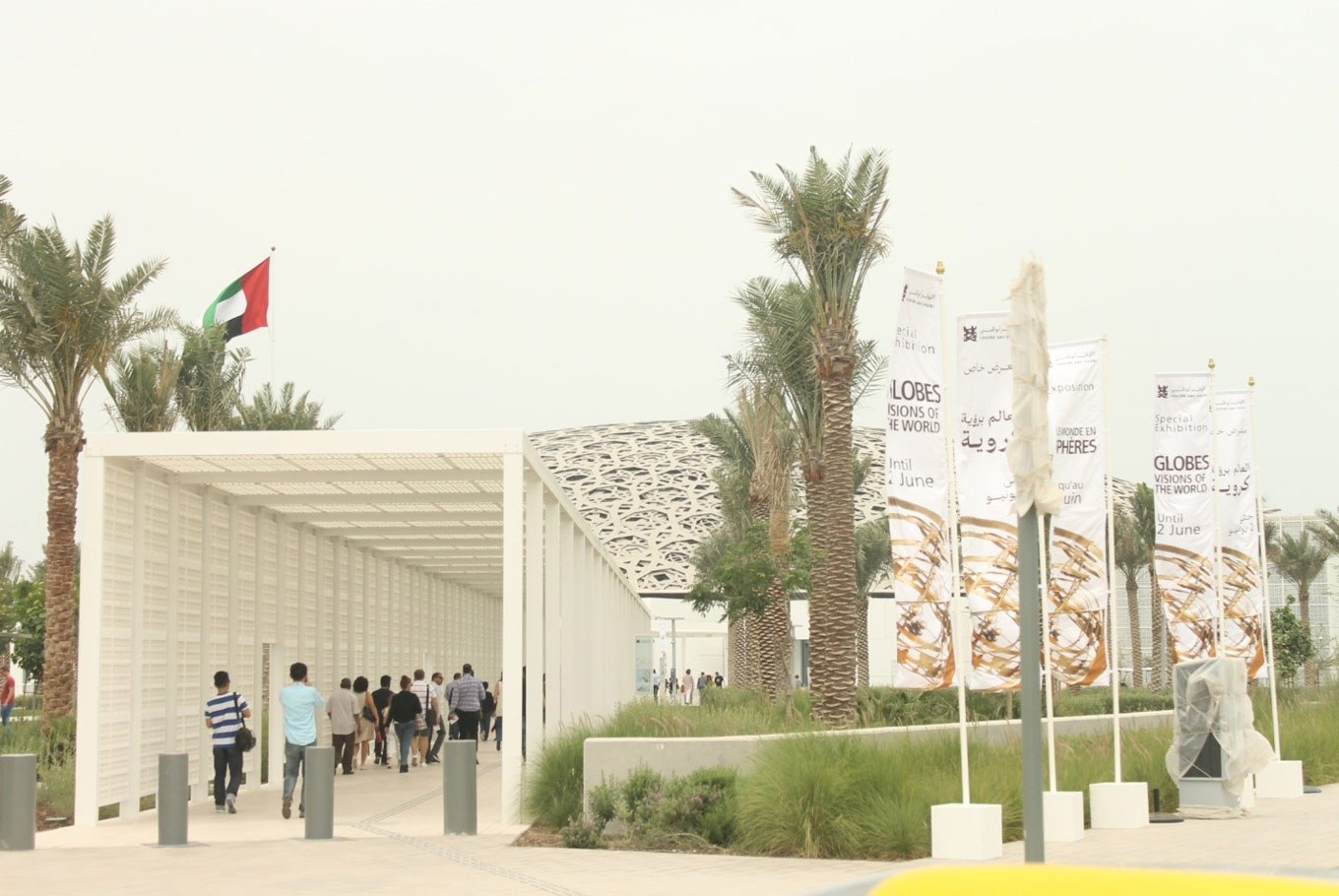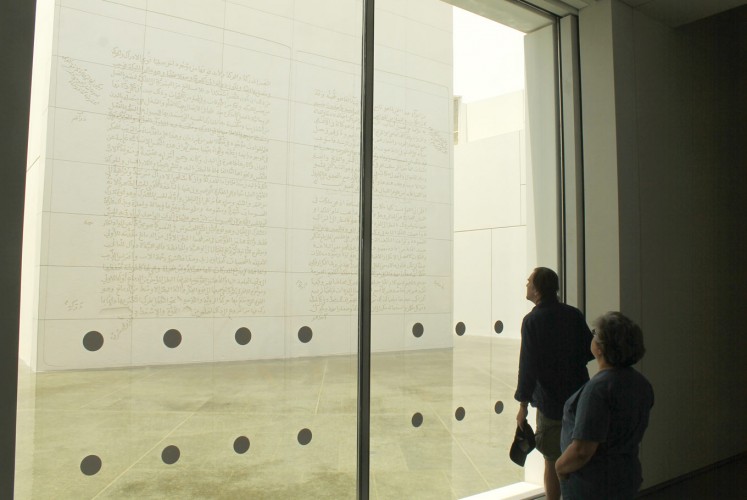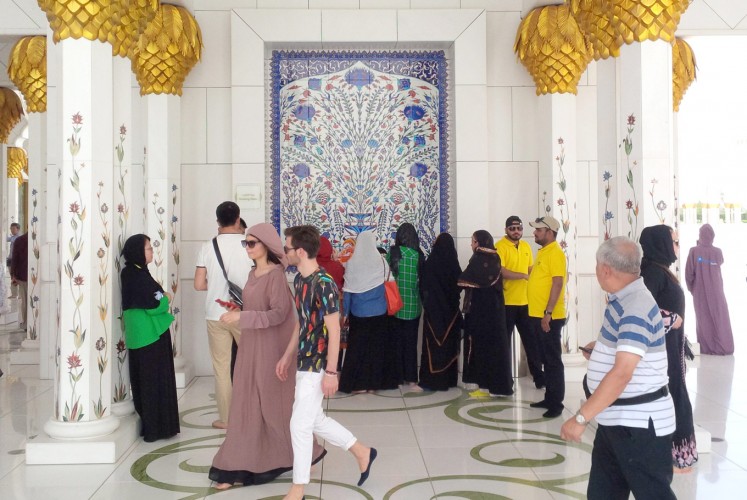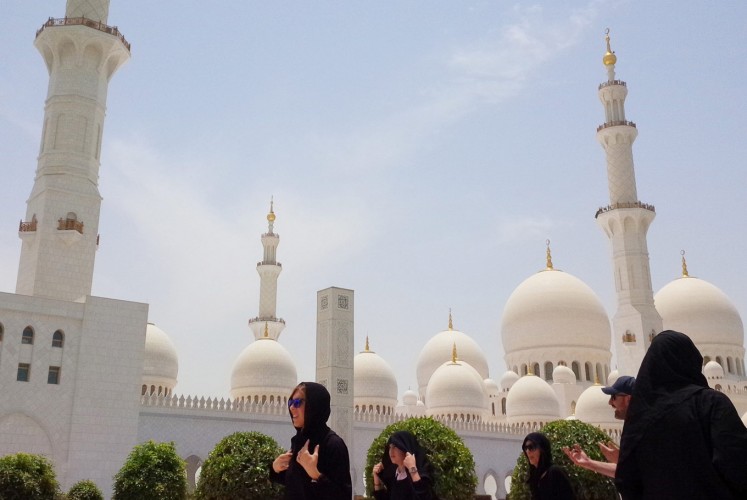Popular Reads
Top Results
Can't find what you're looking for?
View all search resultsPopular Reads
Top Results
Can't find what you're looking for?
View all search resultsFind the beauty of Abu Dhabi in the Louvre and Sheikh Zayed Grand Mosque
Vantage points from the Louvre Abu Dhabi Museum and the Sheikh Zayed Grand Mosque
Change text size
Gift Premium Articles
to Anyone
A
nthropologists found that cultures began establishing religious traditions at the same time as when they started creating pieces of art. The desire for transcendence is intimately connected with the desire for creativity.
In Abu Dhabi, the capital of the United Arab Emirates (UAE), there are two places where religious and creative traditions are linked: the Louvre Abu Dhabi museum, located in Saadiyat Island’s Saadiyat Cultural District, and the Sheikh Zayed Grand Mosque on Sheikh Rashid bin Saeed Street. In both places, visitors can experience how visual arts and architectural design have always been inherent to human civilization.
Inside the ‘floating’ museum
The Louvre Abu Dhabi was named after the Louvre in France because it was the brainchild of the UAE and France in 2007, when the two countries began working together to develop cultural institutions.
The museum is located in Abu Dhabi’s cultural district, bordering the city’s shoreline. The museum, in fact, is an amphibious building, the foundation of which was erected in seawater. Some parts of the museum contain windows through which visitors can see the aquamarine seawater.
The foundation for the museum’s highlighted work of art, a tall limestone relief containing three pages of Arabic script, a project that was commissioned to American artist Jenny Holzer in 2017, stands in and is partly covered by seawater.
Watch and wonder: Visitors admire American visual artist Jenny Holzer’s limestone relief emblazoned with three pages of Arabic script, made in 2007. In the amphibious museum, the relief’s foundation stands on seawater. (JP/Sebastian Partogi)Overall, the museum seeks to celebrate Arabic cultural heritage, while showcasing elements of life in various traditions and embodying the cross-cultural pollination of civilizations from all parts of the world, including Asia, Europe and Africa, showing how history links us together.
To achieve this, the museum has sections showcasing the diversity of rite de passage found within Muslim and Judeo-Christian traditions from Egypt, Greece and Syria, among other countries, explaining how they mark significant moments in human life, from birth and adulthood to parenthood and death.
For instance, one section features a replica of the House of the Dead from the Republic of Fiji in the South Pacific, where locals do not separate the living and the dead the way Western cultures do; the dead reside in homes just like the living do, thereby still integrating them into the community’s daily life, marking death as a natural part of life.
It is different from the West’s conception of death, where it is viewed as a very frightening occurrence and thereby gets shooed as far away from the living as possible through the way they isolate dying people and bury dead bodies as soon as possible.
Read also: 10 must-see attractions in Dubai
The works of art also explain how different traditions incorporate the religious experience into their communal lives. The museum features tiny polished ancient terracotta idols from Turkey, dating back to around 2000 BC. It also showcases similar artifacts from the Roman Empire in the Mediterranean Sea in Europe, Africa and Asia as well as the Han dynasty in China. The museum also features a human-sized statue of Egyptian pharaoh Ramses II, dating back to around 1200 BC.
The museum has a special section that celebrates all global religious traditions, from Buddhism and Christianity to Islam. It features papyri containing sacred scriptures from the traditions, as well as religious art pieces, like tinted glass from Catholic churches that celebrate religious saints.
It also explains how religious traditions bonded different civilizations through the spice trade, which reached its peak in around the 16th century. Spices from India and China, for instance, were exported to Europe as ingredients to make incense to mark Catholic processions.
The museum’s materials and descriptions are available in four languages: English, France, Arabic and Braille. It also features numerous interactive multimedia tools. It provides iPads to its visitors, allowing them to navigate the museum using audiovisual instructions. This is why you see a lot of visitors carrying tablets while putting on earphones while visiting the museum.
Traveling out of time at the grand mosque
Have you become so busy lately that you cannot find time to open up your mind to a sense of wonder? The hustle and bustle of modern life can swallow a person whole, but the Sheikh Zayed Grand Mosque is a place where you can travel out of time to marvel at the architectural beauty created to praise God.
The mosque was named after Sheikh Zayed bin Sultan Al-Nahyan, UAE’s late founding father who came from Abu Dhabi. His funeral ceremony was conducted at the mosque before he was buried at the site.
Just passing by: Visitors walk through the Sheikh Zayed Grand Mosque’s hallway area, which is decoration and designed to evoke a Persian influence. At the center, thirsty guests line up to drink from a fountain water. (JP/Sebastian Partogi)The grand mosque itself is situated on a 17,000-square-meter compound capable of accommodating 40,000 worshippers. The mosque’s interior design brings to mind a Persian influence, with prominent touches of blue, red and green across its décor.
It also features 82 domes, over a 1,000 columns, 24-carat gold-gilded chandeliers and large hand-knitted carpets. The large chandeliers themselves are amazing: They are 10 meters in diameter and 15 meters in height.
Transcendental: Visitors walk through the Sheikh Zayed Grand Mosque compound. (JP/Sebastian Partogi)When you walk inside, you can feel the mosque’s white marble tiles, decorated with floral patterns and bringing a cool touch to your feet. The mosque’s walls and pillars are also made of white marbles. Its pillars, meanwhile, are emblazoned with a touch of golden tops shaped like the branches of a palm tree. The mosque is surrounded by ponds that reflect a blue color, invoking a sense of calm, like the cool marble tiles inside it.
Here, you can walk around while being inspired by the transcendental experience that the mosque’s architecture and design seem to evoke, without worrying about time or day-to-day activities.










